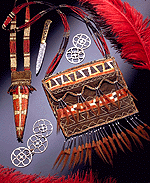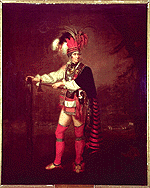
Knife, Sheath, Ear Pendants and Pouch
 |
Collected by Sir John Caldwell in the Eastern Great Lakes region, 1774-1780; Speyer Collection The rare, early artifacts seen here are witness to the variety and complexity of native arts and crafts that once existed in the Great Lakes region. They are from a collection acquired by Sir John Caldwell, an Irish baronet, who proudly displays them in his portrait (now in the Liverpool Museum, England). As an officer in the British 8th Regiment of Foot, Caldwell was assigned to Niagara and Detroit between 1774 and 1780. His position demanded frequent official visits to Indian villages, and he took part in several Indian councils. It was during these trips that he amassed a superb collection of Native objects, which he took back with him to Ireland in 1780. There an unknown artist painted him dressed in his North American finery, which he could wear with some confidence, having been elected a chief of the Ojibwa, allies of the British during the American Revolution. |
 |
The square pouch, the same one Caldwell is shown wearing on his right hip, is made of skin dyed black by boiling it in a mixture of vegetable matter, such as walnut or maple bark, and a mineral containing iron. Flattened and dyed porcupine quills are sewn to the skin in complex geometrical patterns. Such a pouch was traditionally worn by members of a ritual society concerned with hunting and war that flourished briefly in the Eastern Great Lakes region in the mid-1700s. Caldwell's ear pendants and other silver ornaments are typical of the items made by Canadian, British and American silversmiths for the fur trade. Three of the wheels in the photograph are by Robert Cruickshank, of Montreal, and two are by Jonas Schindler, of Quebec City. Other imports, such as the knife, were introduced through trading posts. Caldwell added the decorative plumes to the original headdress. Caldwell's collection remained in Ireland until part of it was acquired by a German collector, Arthur Speyer. When, in 1973, the Museum repatriated the outstanding Speyer collection of Indian objects made during the eighteenth and early nineteenth centuries, it also acquired the Caldwell pieces. |
